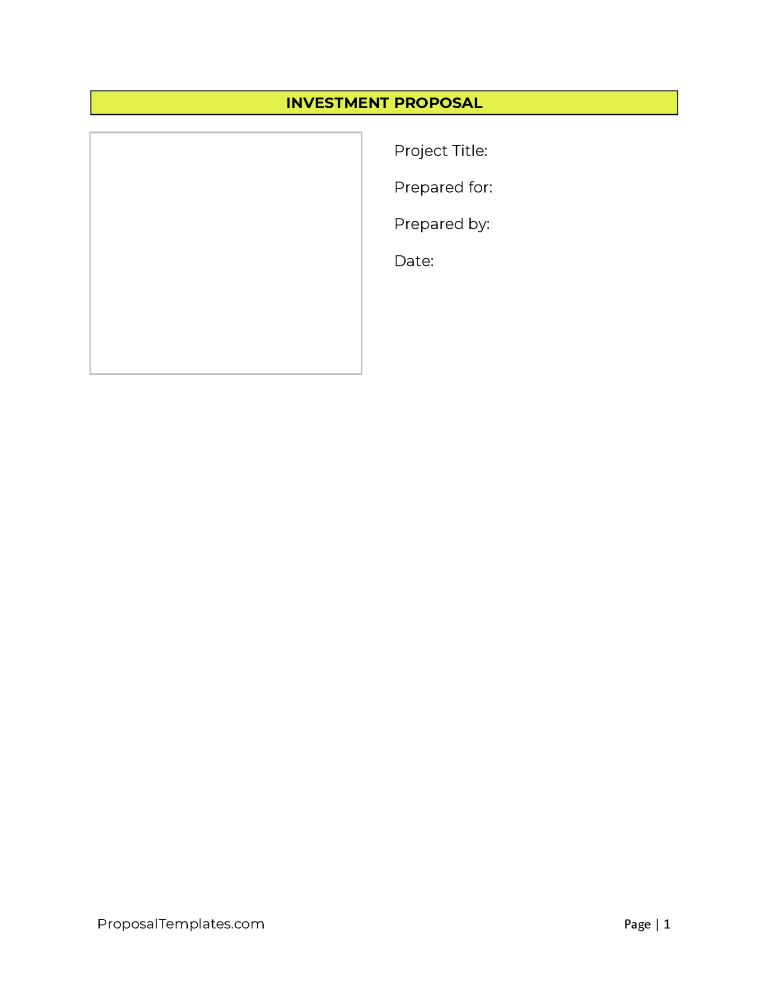An investment proposal is used by various entities once they have reached a project stage requiring outside capital or equity. The investee often promises a return on investment plus other benefits (i.e., equity, recognition).
By Type (13)
What Should Be Included (14 Items) |
1. Investment Executive Summary
Start with an overview of the proposed investment’s unique selling points since this opening must attract the investor. Briefly introduce topics like the return on investment (ROI) together with the investment sought as well.
Introduction, Investment Opportunity
USP, Market Opportunity
Financial Highlights, Call To Action
Management Team, Funding Request
Use Of Funds, Traction, Achievements
2. Introduction To Investment
Introduce the party hoping to obtain an investor while building their credentials and capabilities. For example, frame its background, current competitive status, mission, and growth potential in an effective sales pitch.
Company Overview, Mission
Founding Date
Ownership Structure
Location, Market
Legal Status, Achievements
3. Market Analysis
Analyze the current market or industry as well as the target audience for the investment to succeed. Bear in mind, these demographics have a powerful impact on the potential investor; thus, keep this section accurate and positive.
Market Overview, Segmentation, Target Market
Trends, Dynamics, Competitive Landscape
SWOT, Market Entry Strategy, Regulatory Consideration
Market Research Data, Market Size, Growth Projections
Market Risks, Market Opportunities
4. Investment Opportunity
Explicitly describe the opportunity spurring this proposal by balancing the required investment with the benefits or profits it potentially yields. That is, specifically, name the sought capital and the investment’s ROI.
Funding Request, Purpose Of Funds
Use Of Proceeds, Investment Type, Investment Terms
Objectives, Milestones, Investment Benefits
Timeline, Exit Strategy
Risk Assessment, ROI
5. Business Model
Discuss the operations and revenue generation of the business requiring this investment. For example, present its distribution channels, its profitability, as well as its sales and marketing plans.
Impact On Business Growth, Investor Support
ROI, Equity Ownership, Voting Rights, Social Impacts
Dividend Payments, Preferred Terms, Tax Benefits
Exit Opportunities, Risk Mitigation, Legal Considerations
Use Of Funds, Competitive Advantage, Transparency
6. Financial Projections
Present the revenue forecasts for the investment as well as its expense estimates. In essence, provide an extensive discussion of its financial performance projections.
Revenue Projections, Sales Assumptions, Scenarios
EBITDA, Sensitivity Analysis, Assumptions, Risks
Net Profit (Net Income Or Earnings)
Balance Sheet, Historical Data, Cost Of Goods Sold (COGS)
Financial Ratios, Break-Even Analysis
7. Management Team
Introduce the team managing the investment significantly building their qualifications and experience. Additionally, dispense the team’s structure and roles.
Executive Team Overview, Professional Experience
Biographies, Backgrounds, Industry Expertise
Testimonials, Track Records, Roles
Team Dynamics, Dedication, Past Success Stories
Continued Development, Advisors, Contace Material
8. Competitive Analysis
Provide the SWOT analysis (strengths, weaknesses, opportunities, threats) defining the investment since every investor will seek this information. Additionally, list the company’s competitors with a comparison to the investee company.
Market Share, Positioning, SWOT Analysis
Market Penetration, Pricing Strategy, Customer Feedback
Product/Service Comparisons, Risks, Mitigation
Customer Acquisition, Marketing Strategy
Barriers, Distribution Channels, Market Trends
9. Risk Factors
Identify every risk to the profitability of the investment together with the safeguards in place. That is, fully lay out the contingencies and mitigation plan in place for every possible risk to the investment.
Risk Identification, Market, Operational, Financial Risks
Regulatory Compliance, Team/Human Resources
Product/Services, Cybersecurity, Intellectual Property
Data Privace, Geopolitical, Global, Natural Disasters
Probability Severity, Unresolved Issues, Investor Impact
10. Use Of Funds
Spell out how the investment capital or equity will be used for the investment in detail. Significantly focus on a full discussion regarding the ROI for this opportunity.
Total Funding Amount, Itemized Allocation
Working Capital, Reserves, Expenditure (CapEx)
Innovation, Product Development, Marketing, Expansion
Operational Expenses, Scaling, Expantion, Investor Benefits
Visual Aids, Regulatory Compliance, Debt Repayment
11. Exit Strategy
Provide the exit strategies in place, such as buybacks or initial public offerings (IPO). Equally important, describe the manner and schedule by which the investor can expect to realize their ROI.
Overview, Primary Exit Strategy, Secondary Exit Strategies
Exiting Timeline, Triggers, Negotiation Process
Investor Returns, Proceed Distribution, Investors Role
Consent, Valuation, Pricing, Investor Interests
Communication Plan, Risk Contingencies
12. Legal Considerations
Fully disclose the legal information (i.e., security laws) governing the investment. Additionally, enclose a copy of every such document, such as required licenses, permits, and proofs of compliance.
Regulatory Framework, Compliance Assurance
Environmental Regulations, Labor And Employment Laws
Contractual Agreements, Litigation And Disputes
Intellectual Property Protections, Data Privacy And Security
Legal Counsel, Insurance Cover, Risks, Mitigation, Reporting
13. Appendices
Read through the above proposal, then combine all the remaining attachments in this section accordingly. For example, oversized documents such as media, blueprints, and patents can all be gathered in the appendices section.
Financial Statements, Market Research, References, Endorsements
Pro Forma Financials, Surveys, Product/Service Demos
Legal Documents, Customer Testimonials, Letters Of Intent
Case Studies, Competitive Analysis, Customer Aquisition Strategy
Patents, Intellectual Property, Photos/Visuals, Regulatory Approval
14. Contact Information
Spell out how the investment capital or equity will be used for the investment in detail. Significantly focus on a full discussion regarding the ROI for this opportunity.
Company Name, Address, Phone, Fax, Email
Websites, Investor Contact Details
Management Team Contact Information
Legal Counsel/Advisor Contact Material
Availability, Estimated Response Times

